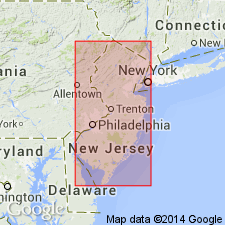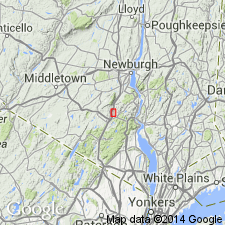
- Usage in publication:
-
- Kanouse sandstone*
- Modifications:
-
- Named
- Dominant lithology:
-
- Sandstone
- Conglomerate
- AAPG geologic province:
-
- Piedmont-Blue Ridge province
Summary:
Kanouse sandstone. Introduced to replace [objectionable] name "New Foundland grit." Thick-bedded fine-grained conglomerate below and greenish sandstone above. Thickness 215 feet. Underlies Pequanac [Cornwall] shale and rests on Decker limestone. Carries Onondaga fauna. Exposed in valley west of Kanouse Mountain, Passaic County, New Jersey.
Source: US geologic names lexicon (USGS Bull. 896, p. 1069).

- Usage in publication:
-
- Kanouse sandstone*
- Modifications:
-
- Overview
- Age modified
- AAPG geologic province:
-
- Piedmont-Blue Ridge province
Summary:
In Highland Mills area, NY, overlies Woodbury Creek member (new) of Esopus formation. Upper contact with overlying Cornwall shale, of Hamilton age, not exposed. Minimum thickness 50 ft. Contains fauna of Onondaga age, now considered Early Devonian.
Source: GNU records (USGS DDS-6; Reston GNULEX).
For more information, please contact Nancy Stamm, Geologic Names Committee Secretary.
Asterisk (*) indicates published by U.S. Geological Survey authors.
"No current usage" (†) implies that a name has been abandoned or has fallen into disuse. Former usage and, if known, replacement name given in parentheses ( ).
Slash (/) indicates name conflicts with nomenclatural guidelines (CSN, 1933; ACSN, 1961, 1970; NACSN, 1983, 2005, 2021). May be explained within brackets ([ ]).

